If you got to this post early you might have seen it without its photos. In my excitement I hit the publish button in error. My apologies. Here’s how it should look…
Weather.
I once loved the Wainwright quote of “There’s no such thing as bad weather, just unsuitable clothing.” Now I think he had it wrong. Weather has a big impact on mood. I can be happy doing little in the sunshine, but when the rain falls I have to take action.
Mediterranean storms hit hard.
Being in the van when the rains come gives you a sense of being in a washing machine. The thunder suggests that washing machine is clattering down stairs.
For several days we’ve had punishing hail and torrential rains. Deafening thunder has shaken our very souls.
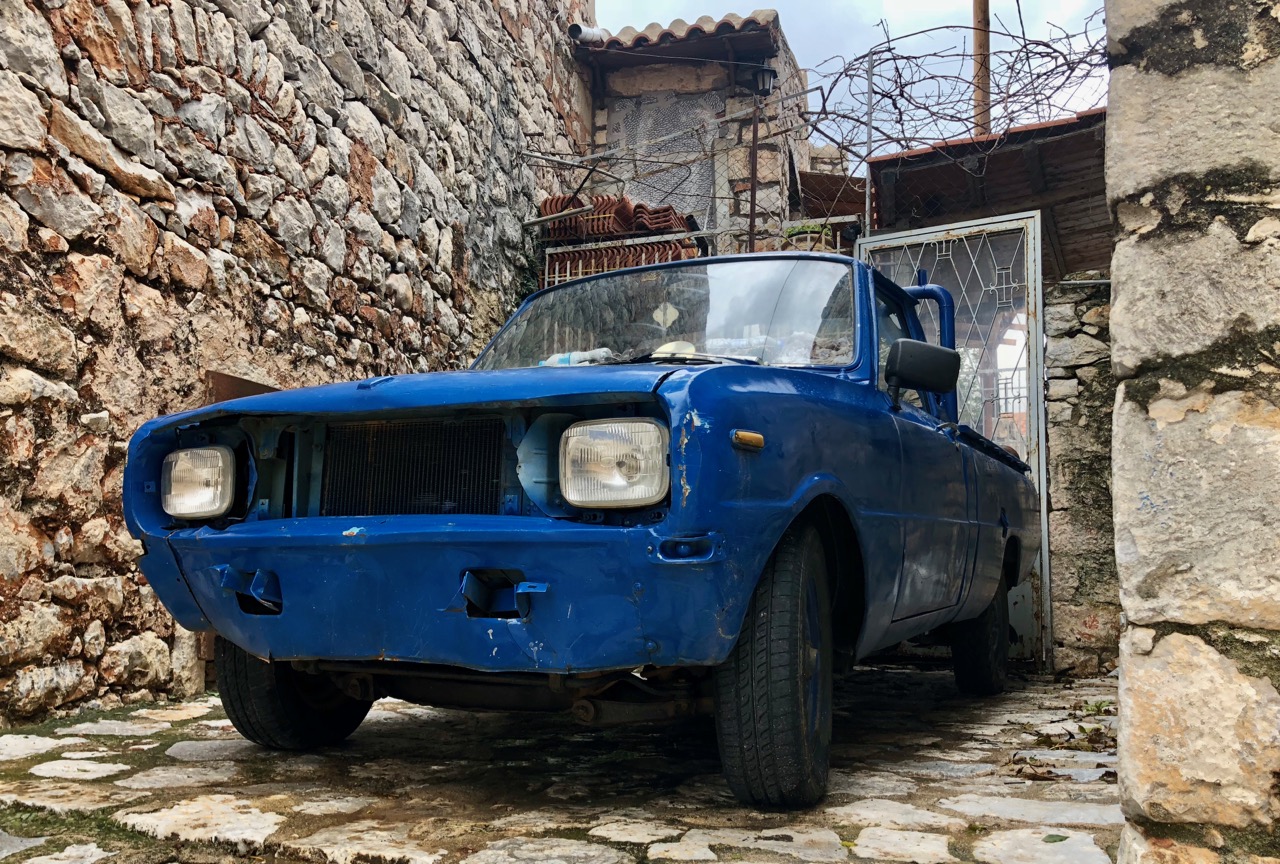
Saturday night’s beach at Sadova would have been a perfect place to spend a few days, but as the windows steamed up and our spirits began to sink we knew action was needed.
The next stop was Kardamyli, less than twenty miles away, a short hop over the foothills of the Targetus, the mountain range that makes up The Mani.
The moment we left the beach road we began to climb at about 20% gradient, a narrow winding road with many switchbacks that couldn’t be taken in one go. It’s a road that would make many blanche on a good day. Today it was far more interesting. Reversing towards a precipice that you can’t even see makes for challenging van driving.
A torrent of water rushed down the road, another was falling from the sky. Wipers on full speed, visibility minimal, deep drops at the roadside, and to add excitement the temperature was falling. I was flicking my gaze between the road and the thermometer, hoping against hope that the height wouldn’t bring ice too.
This time it didn’t.
After a high village with as many churches as houses we joined a wider road that wound back down the mountainside offering glimpses of Kardamyli far below.
Patrick Leigh Fermor.
I was looking forward to Kalamata last week.
I was looking forward to Kardamyli far more.
The small village was the long term home of writer Patrick Leigh Fermor whose books have accompanied much of this journey so far. I picked up the second part of the trilogy that documents his walk to Constantinople when I was alone in Romania, and found myself in the very town that I started reading about.
For the last week or so I’ve been reading a few pages of The Mani each day in preparation for arriving at this, the middle peninsula of three at the base of the Peloponnese.
All this by chance. Just before leaving St Just our friend Will Bauress mentioned PLF, and my sister Janice bought his A Time of Gifts to accompany our arrival in continental Europe.
Now, thanks to PLF, I am intrigued by this wild land at the end of the (Greek) world. A land that the Ottomans failed to tame. A people that resisted the Bavarian rule of the 1800s. And a place where people could only tolerate each other when united by a common enemy. As soon as the enemy was dispatched with, and they all were, they took to fighting each other, building towers from which to attack their neighbours.
The Deep Mani is little more than a mountain range reaching down into the sea on both sides. High mountains at that. The highest, Mount Profitis Ilias tops 2400m. Further south than where we are at the moment it’s a barren rocky place that has received little attention until now. I look forward to getting there later in the week.
Now though the sun is shining for the first time in days. The greens are greener, the sky an incredible blue, the mountains snow capped and our world is more beautiful than it has been for days. We have to get out there and explore.
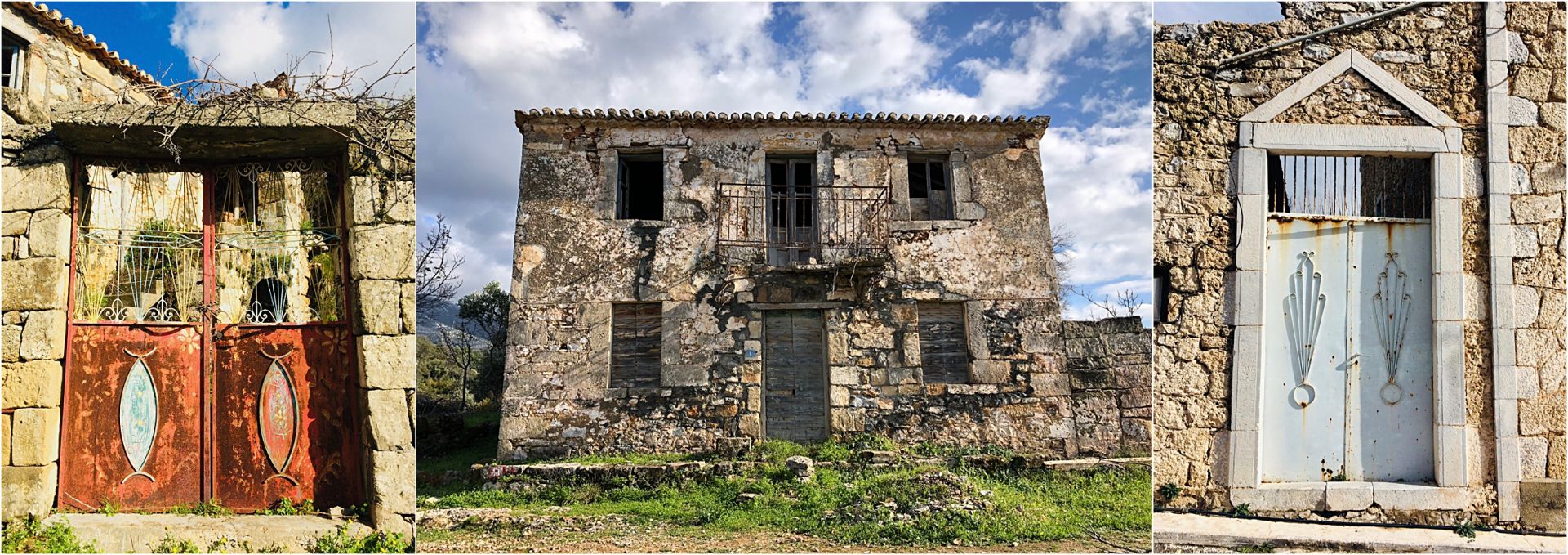
Agio Sofia stank.
There’s a sign pointing off the road for Old Kardamyli so we started there. A wealthy family’s little settlement has been restored with tower, grain store, smithy and church all in a good state of repair. It’s easy to imagine it functioning as a mini fortress.
From there a well made path climbed quickly, passing springs on the way. At Agio Sofia a pretty church stands near the edge commanding a superb view down over the coast, and up to the high mountains behind. It’s a shame, but understandable, that churches are all locked around here. Each is individual in its decoration. Most more ornate than you’d expect for out of the way places.
The village is pretty with many restored houses. Lots of European languages are spoken there by the German, Dutch and English dwellers who have brought it back to life. There are even a few Greeks living there too.
Pretty though the village is, and the view spectacular, it’s a heck of a climb on foot, and the road is long and winding. I suspect it would get tiresome after a while, although it’s the lack of a taverna that would put me off the most.
Another cobbled path took us back down via Petrovouni with a far reaching view over the bay. The last mile on the road led us straight to lunch – possibly the best burger ever, enjoyed in a small café. The meat included mint and sage, a tasty combination.
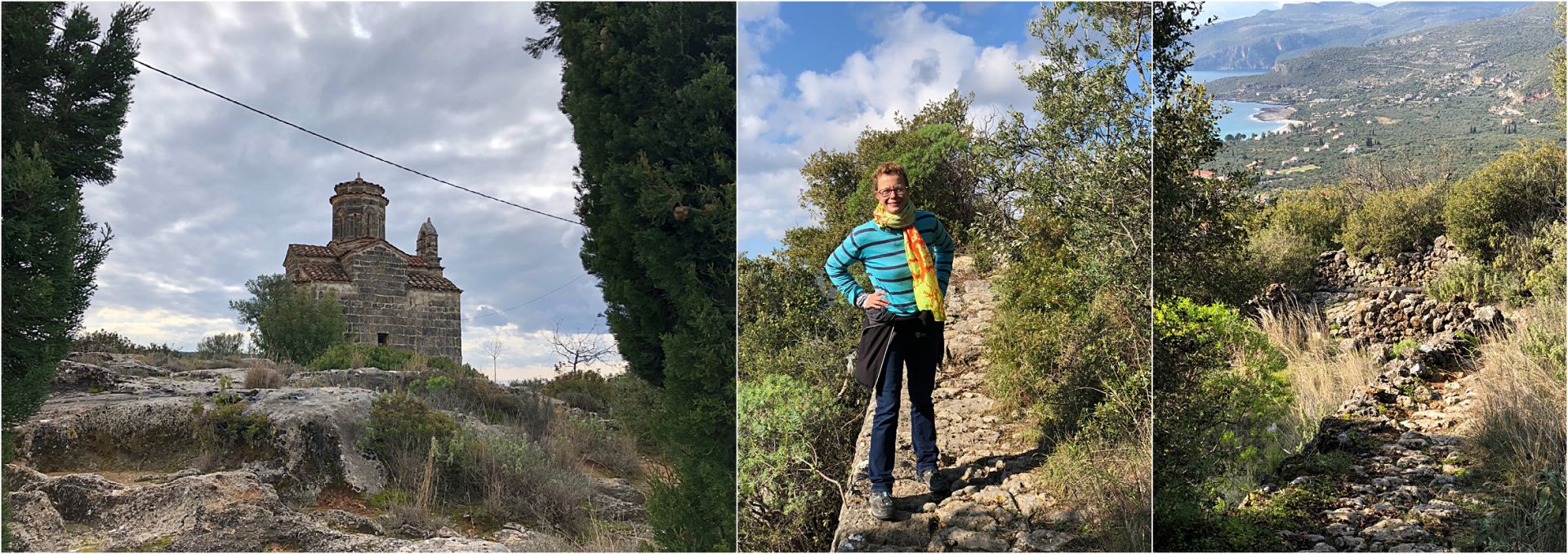
Towers old and new.
Reading information on the area suggests that it bristles with towers in a San Gimignano fashion. It doesn’t (so far at least), but there are lots of small ones.
The trouble is planners are keen to maintain the vernacular and now so many new houses resemble towers it’s hard to know what’s original. The new ones may have perfect angles and straight lines, but even they tend towards ragged tops to give an authentic feel.
Further south we’ll encounter less accessible places where nothing has been restored.
The Deep Mani.
The transformation from the Outer Mani (northern) to the Deep Mani (further south) is well defined. Suddenly the lush vegetation is replaced by much lower scrub. Only a few brave Cypresses stand tall. Few other trees top twenty feet and the olives are more stunted than elsewhere.
It’s said that after God had finished making the earth he dumped his left over stone on The Mani – it certainly is boulder strewn. It has a reputation for wild weather too. So far it has been rather wet, but fortunately we’ve been spared thunder for a couple of nights, and the better sleep is much welcomed.

Areopoli.
The town of Ares, god of war. It was here that Petros Mavromichalis started the Greek war of independence in 1821 and there are more towers than we have seen so far. The town feels tough in the cold weather. Narrow paved streets merge with the towers as all are cut from the same stone.
Where we fuel up feels like the wild west. Abandoned pickups take the place of horses.
We camp at the fantastic Diros Beach not far out of town. Three vans from the previous night’s stop are here too.
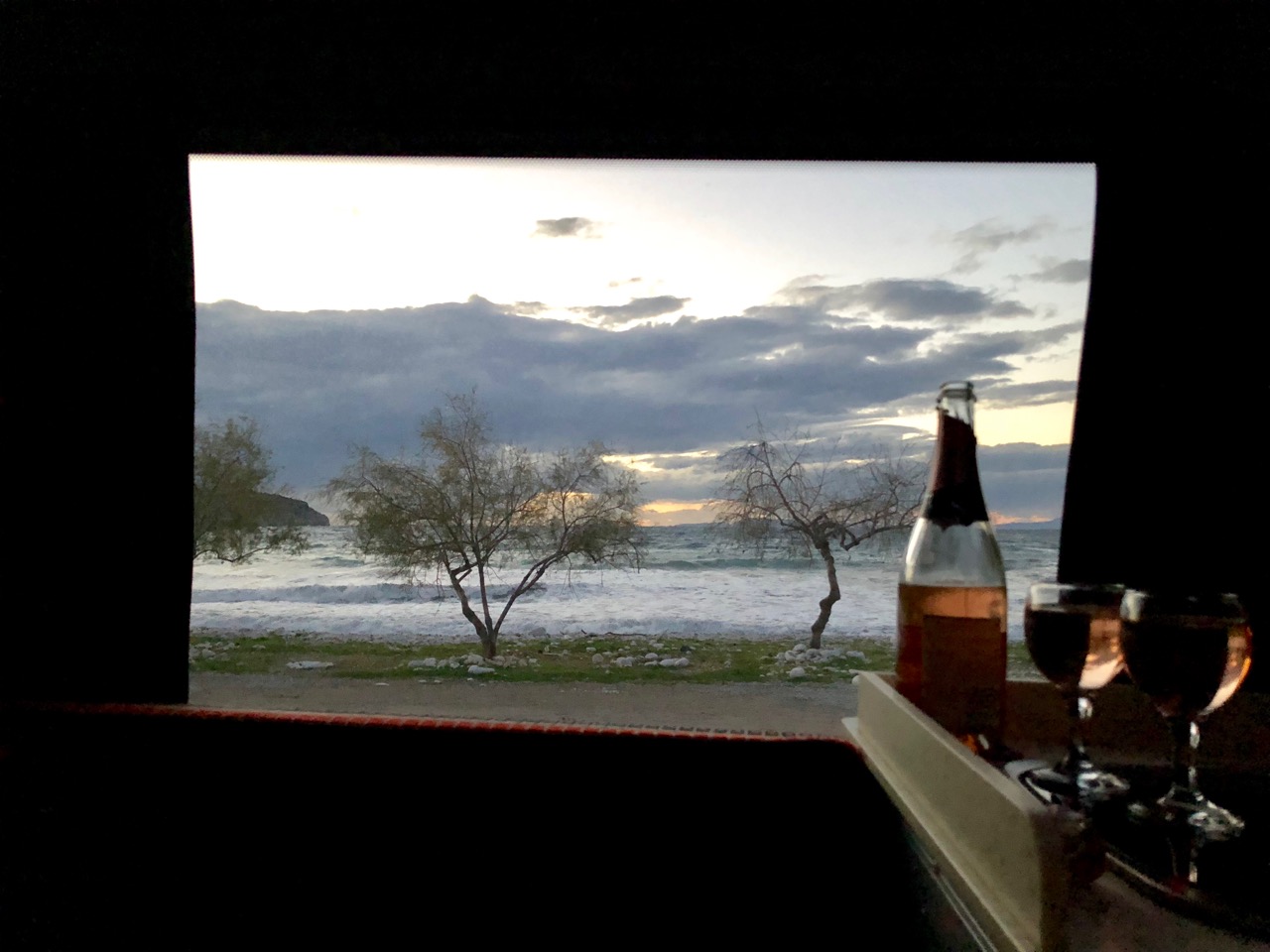
A white boulder beach where the rocks roll their all night lullaby with the waves roaring in accompaniment. Soft bottlebrush trees line the edge. This is apparently overcrowded in summer, but in January there’s space and emptiness.
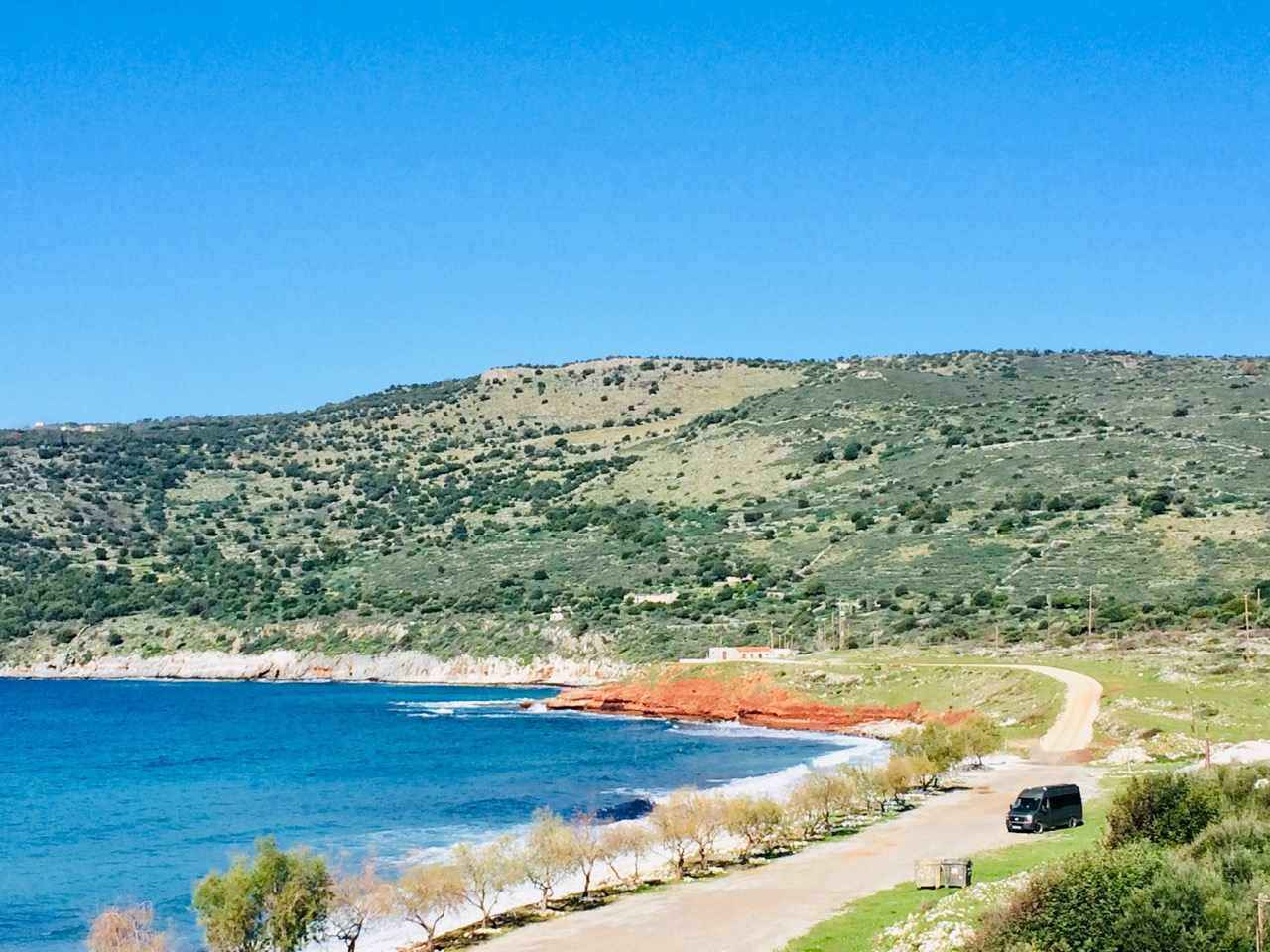
We take a good walk back to Areopoli, but the path back hasn’t been taken by anything other than cows for a good few years. The scramble through overgrown scrub left many scratches. Scratchy yes, but it slowed us down enough to appreciate our surroundings in the falling afternoon light.
Two mornings later and we’re still at Diros.
Long awaited sunshine came so warm and welcome that to move on would have been a shame.
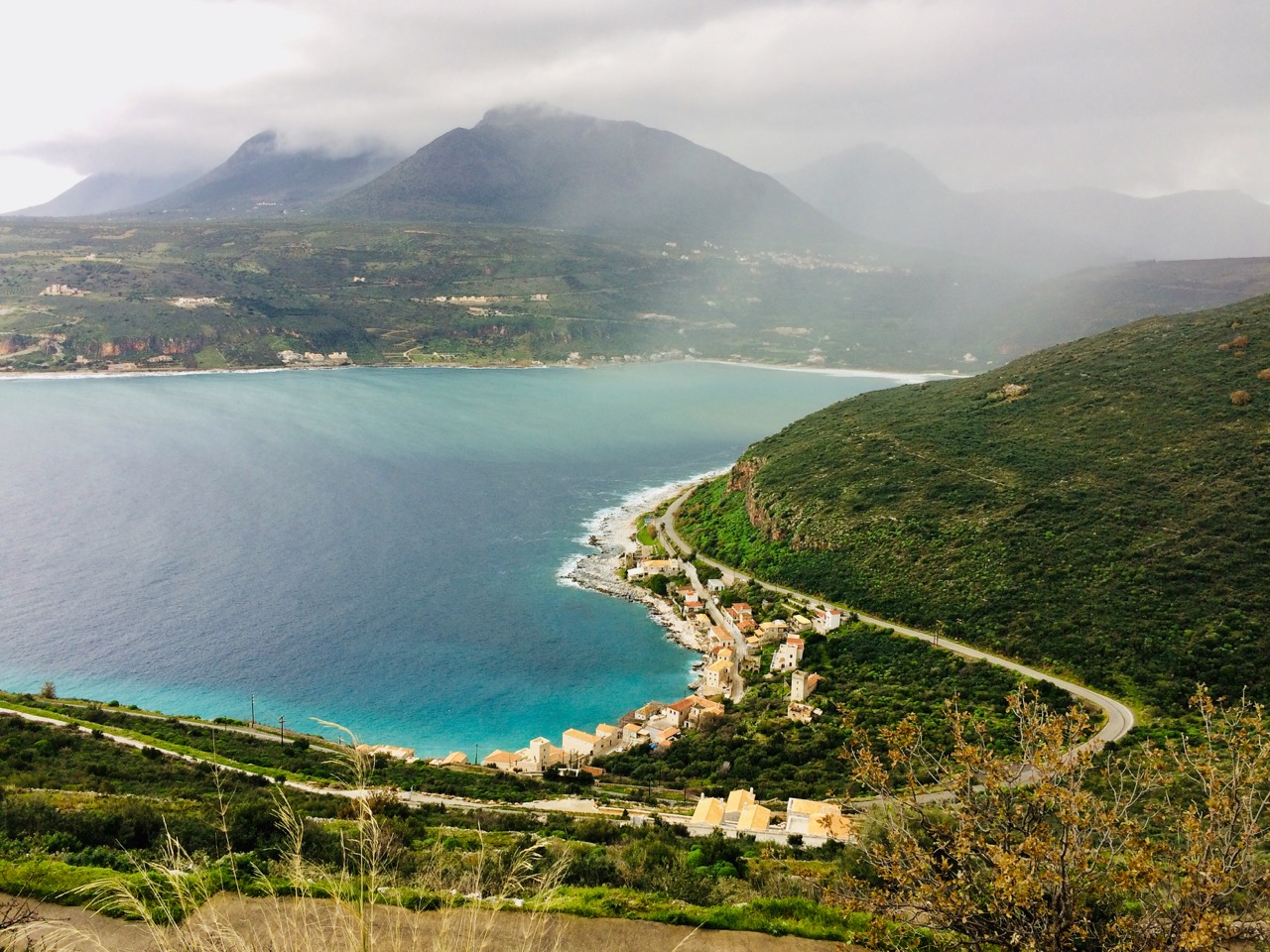
Spring?
The Greeks tell us spring will arrive on the 21stJanuary.
Although that feels optimistic there are certainly a lot of flowers bursting out. Each day brings a new explosion, mainly of yellows, but various shades of anemone add variety. There are blooms on the world’s spricklyest gorse, many daisies, camomile, tiny marigolds, a bush similar to broom, and a score of different euphorbia, all taking the hillsides to a new level of interest.
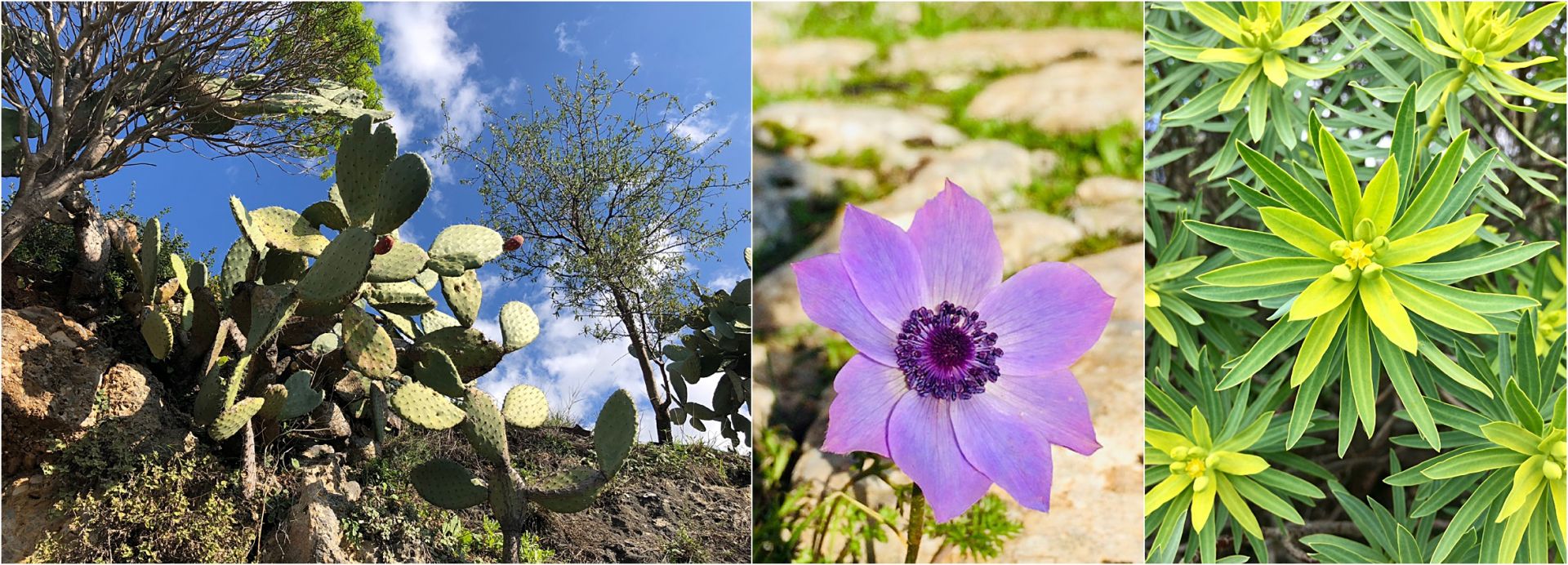
Even Deeper Mani.
The further we travel south the more the rocks take over from the green, and the more brisling the towers.
Life here must have been so hard.
There’s little soil.
There are very few trees.
The wind whips the peninsula mercilessly.
Until the late 1950s there weren’t even any tarmac roads linking the area to the rest of the Peloponnese.
So what do you do when life is hard?
Well you dedicate yourself to making life harder for everyone else it seems. Every family that could afford to built itself a tower from which to defend themselves, and ideally attack its neighbours. Blood feuds lasted generations until one side was wiped out, or they fled.
When I’d read about the towers and the family feuds that led to them I expected there was a lot of literary license involved – now I’m here I suspect that it actually was the mad place that stories present.
The last great family feud needed the army to force a truce in 1870. But Greece has hardly been stable since, world wars, civil wars, expansionist policies, boom and bust. All have taken their toll.

Come soon to see The Mani at its best.
Here at the very end the hills are steep, the roads narrow and the scenery wild.
Today this rugged place has a deep beauty. Best seen when empty, as we have it now.
Come soon though – it may already be past its best.
Many towers are in a state of ruin but there is a lot of development work going on. Repairing towers, and creating new buildings that match their style, some road building, but not much.
When I talk of development don’t think of it in the Spanish sense. Most of what is happening is small scale and generally sympathetic to its surroundings. This land will remain beautiful, though it will be softened by repair.

Cape Tenaro. The most southerly point.
By now the olives have given up and only a gorse like scrub prevails. There are more rocks than soil, and yet the tower settlements continue right to the very end. The most dramatic are Vathia and Laghia, both perched high and commanding distant views, the first to the west, the latter to the east.
It’s winter and there are few people around. No boatmen wait to take us to the cave that’s the entrance to Hades. Instead we walk out to the lighthouse at Cape Tenaro in bright warm sunshine. We may not be lying on the beach in this temperature, but having the place to ourselves is plenty compensation.
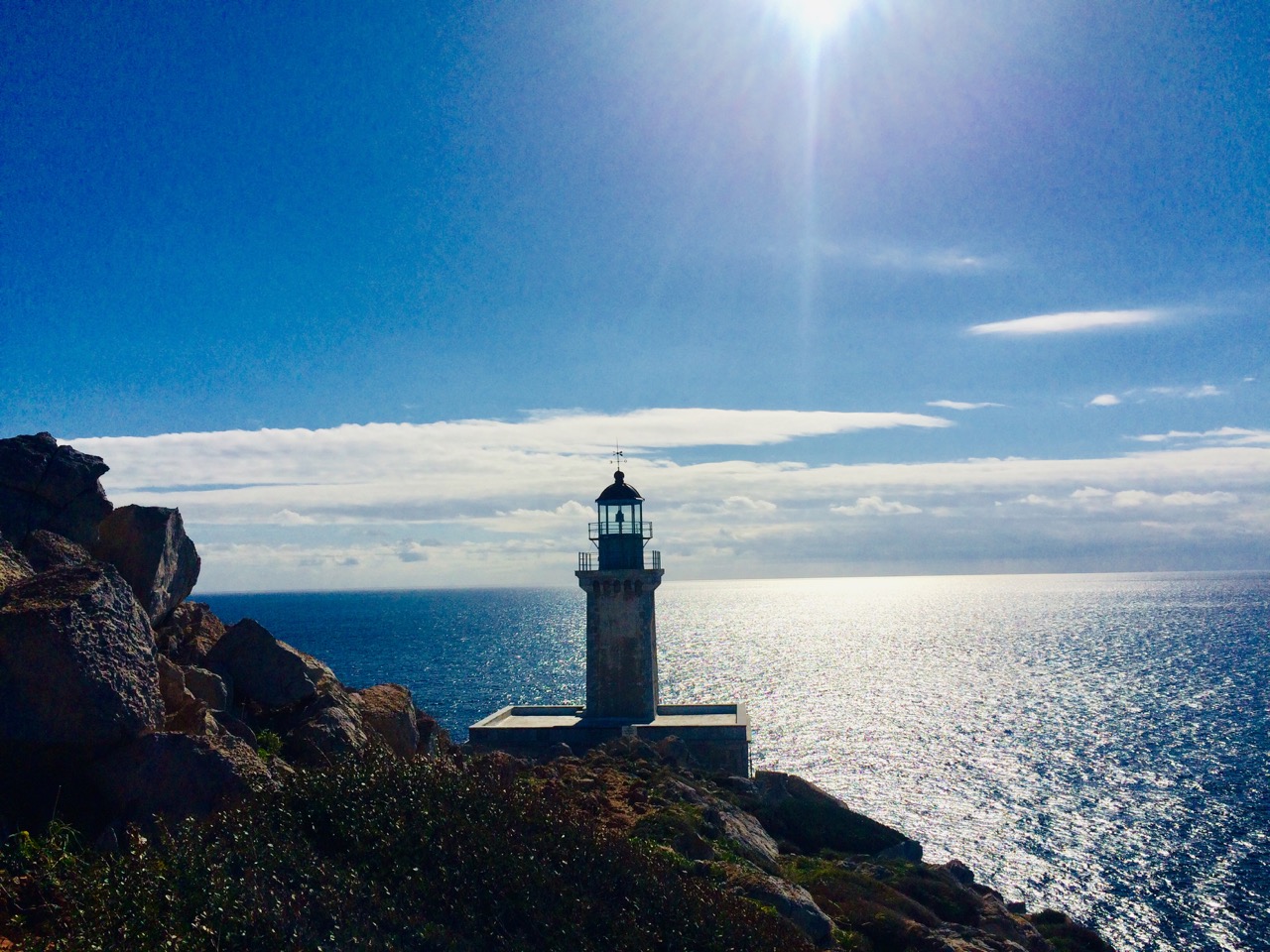
On Friday we woke at Porto Kaghio from where we climbed slowly in first and second gear until Laghia, a hard looking place where the tales of fighting are easy to believe. In two hours I didn’t touch top gear and the fuel consumption dropped to just 20mpg. Two hours was enough, and I was glad to arrive at our harbour wall parking spot at Kotronas where we met up again with the two German and one English vans travelling in convoy. Our third night in their company.
Now on Saturday morning the rain lashes down again, the van smells of wet dog, and the steamed up windows obscure the mountains meets sea view, but it has been a great week.
Few miles but so much seen.
Time has definitely taken a different dimension, one that seems to matter less.
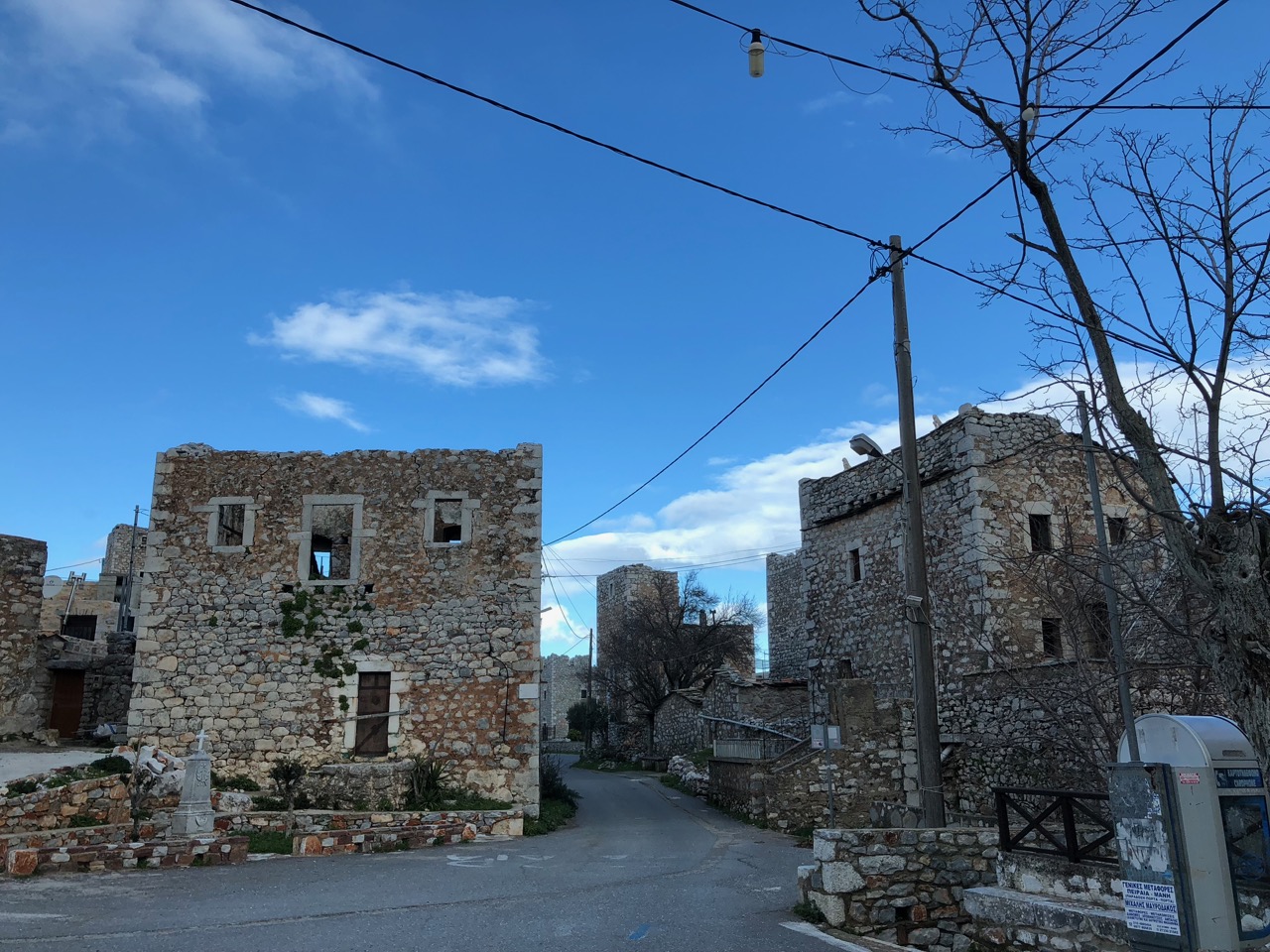
Litter.
We’ve been disappointed by the level of litter in beauty spots of many recent countries, Greece included.
Here in the far south it’s much better.
We’ve resolved to collect a big bin bag full wherever we stay as our payment for an otherwise free night in an amazing place. It’s not always easy, especially in an urban situation where the locals seem happy to live with what’s lying at their feet. That’s when Polly comes in handy – you only have to touch a bottle with your foot and she’ll pick it up and carry it for miles.
VanLife – taste.
You may know that at altitude your taste buds become less effective. Airline food is heavier spiced, more heavily salted, than you’d ever eat at home.
We seem to be experiencing that effect in the van too.
Minty’s desire for strong foods has increased – and I’m delighted. I usually have to hold back when cooking for others, but now my spice shaking and garlic chopping is allowed free rein.
Best meal this week? Chick pea and cauliflower curry, served with spelt instead of rice, and some firey chutneys. Our food is simple, rarely includes meat, but blimey it’s good!
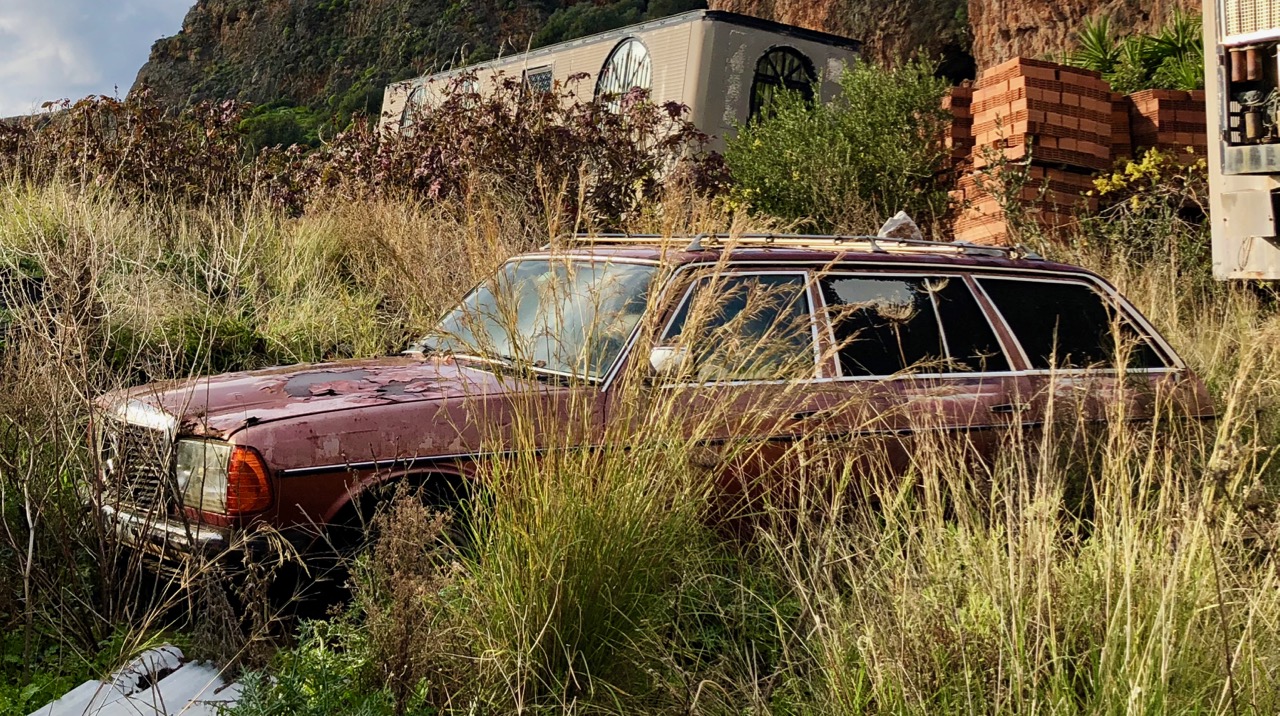
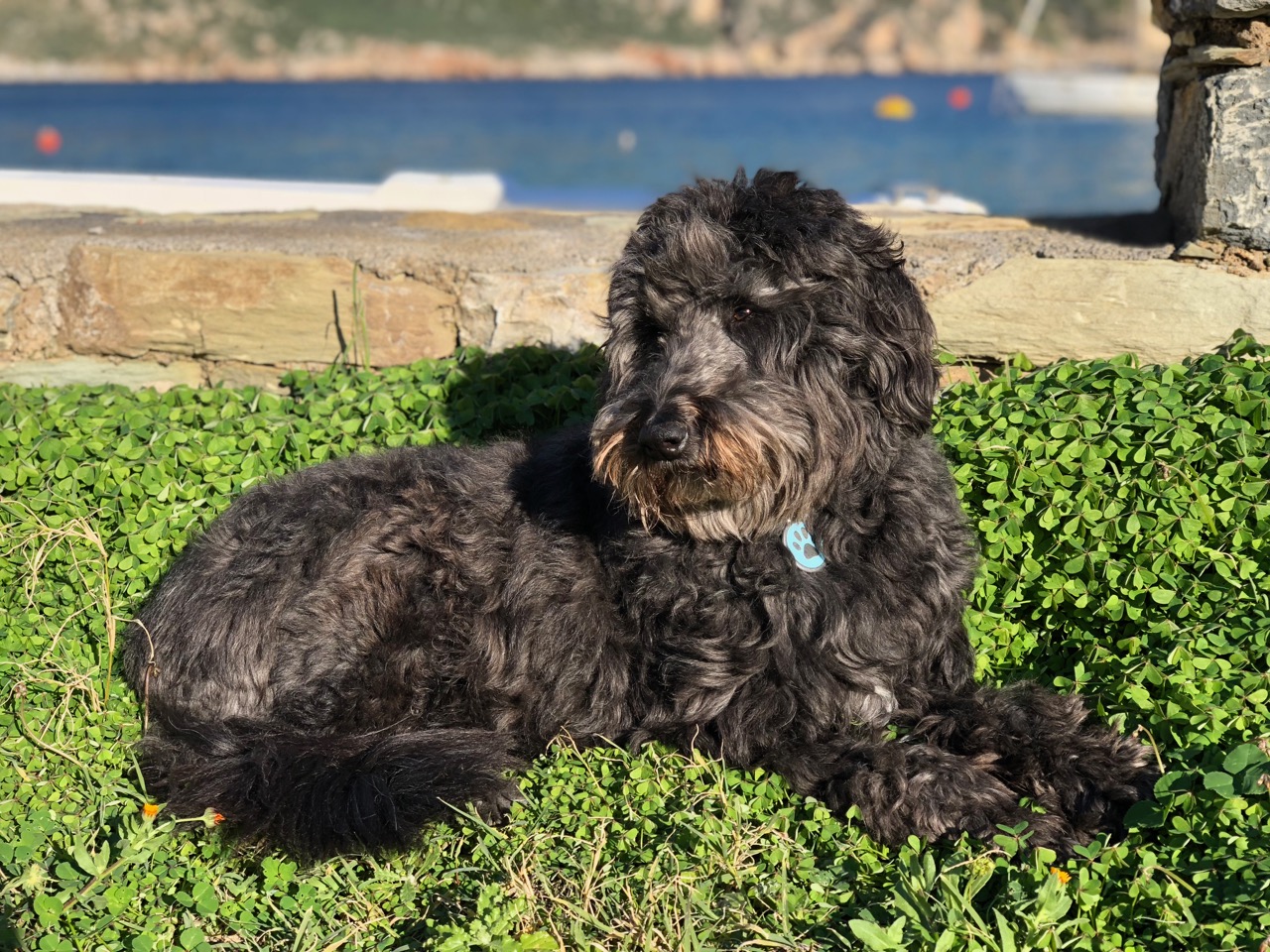


Kelvin the last time we spoke I had just finished reading ‘Kidnapped in Crete’ which tells the story of how an SOE unit led by PLF kidnapped a German General on occupied Crete (the film ‘Ill Met By Moonlight’ was based on it). You recommended A Time of Gifts as my next read. Thanks, really enjoyed it and knowing what he went on to do in later life somehow made the book even more engaging. Written in a completely different era where despite the threat of impending war people were willing to provide an evenings lodgings to complete strangers.
Safe travels! Gx
Thanks Gillian
I’m reading Mani as we travel and we keep ending up in the same place as he was writing about – so much has changed! Going to 50s England would be pretty strange for us too I guess.
I have the Crete adventure and intended to read it when we got there. We’ve now decided to put that trip off for 12 months or so.
Best to you both. KC.
Lovely photo precious Polly
Again very interesting Geography/ History Lesson much better than school
Take care. Enjoy. Hugs to Polly
Luv Dad/Gill??
Thanks Gill
I’m read up on modern Greek history – it makes Britain’s current turmoil look like child’s play!
KC
Your talk of towers put me in mind of tin mines in another part of the world you know well.
Ah yes, you’re right. I did feel at my most wistful on The Mani and perhaps it’s the towers that left me that way.
Good to have your comments Mr F. They’re always welcome.
KC.